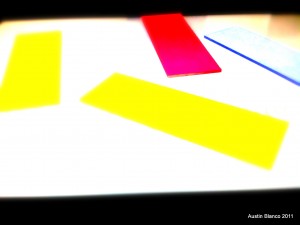
If you have a laser launch, you may wonder if the launch is putting out the same level of power it did as the day it was installed. One of the difficult aspects of using a laser launch is that the single mode fibers required for launching, are very, very small! Lasers are coupled into the fiber connection by means of spring-tensioned, user-adjusted, mirrors, filters and prisms. Ultimately, this means that due to barometric pressure, temperature, vibration, impact and other issues, your laser launch will drift in it’s performance over time. While everyone would ideally own and use a laser power meter, these units are expensive. So, is there a simple, quantitative way to measure laser power?
One method is to simply use a Chroma Autofluorescent plastic slide set. The cost a whopping $ 7.50US! What they provide is a rather linear test standard. Using various light sources, I’ve never seen these decay in response to illumination over time. As these slides are not guaranteed by chroma to be quantitative,a simple time lapse acquisition over several thousand or hundred images an hour should prove this claim to be accurate on your instrument, with the slides you purchase.(Run a timelapse overnight to prove it to yourself!)
If we assume these slides don’t decay over time, we can also then assume that any change in fluorescent intensity is due to something other than the slide, e.g. the microscope filters, or the illumination train or source. As laser grade filters don’t need to absorb heat like white light filters do, it stands to reason that any change in fluorescent intensity is due to a change in laser launch output. (The fiber can also be a cause, but we’ll ignore that for now, as launch alignment is a common issue overall).
So, one can determine whether a laser launch has gone out of alignment or not, by simply placing this standard on the scope, and running a live camera readout. Put another way, you can use your camera, in conjunction with a chroma slide, as a power measurement. Yes, this is not simply indicating laser power (it includes overall optical train errors), but for most applications this isn’t relevant. What we care about is how well the system is illuminating. Whether the problem is with a filter, objective, or launch is another story, but at minimum using a chroma slide and a camera can tell you if there is a change in total system efficiency, and can also aid you in aligning a laser launch should you not have access to a laser power meter. Simply run a live image of the chroma slide, and begin adjusting your launch. When the power peaks for your adjustment on the launch, you have reached the maximum power of the coupling for that laser line. If you have a launch where things are grossly out of alignment, you might consider using a laser test block, to get a gross coupling of the laser into the fiber.
The ideal world view would be that everyone who owns a laser launch also owns a power meter. Suffice it to say, the current economic situation doesn’t allow for this to be a practicality, nor will it likely ever be. So, we must find other ways to test our equipment. This is just one of many!
-Austin